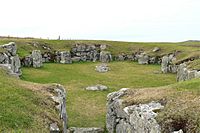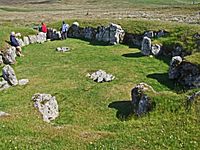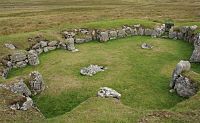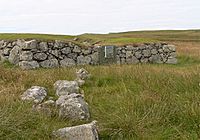Stanydale Temple facts for kids
Quick facts for kids Stanydale Temple |
|
|---|---|
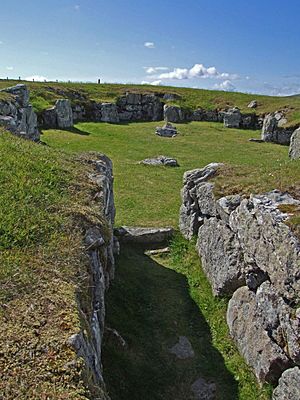
Stanydale
|
|
| Location | Mainland, Shetland, Scotland |
| Built | Neolithic age |
| Lua error in Module:Location_map at line 420: attempt to index field 'wikibase' (a nil value). | |
Stanydale Temple is an amazing ancient place in Shetland, Scotland. It was built a very long time ago, during the Neolithic age, also known as the New Stone Age. You can find it in a field on Mainland, the largest island in Shetland. It's about 21 miles (34 km) northwest of Lerwick, a bigger town nearby.
This site used to be a large building with a roof. Today, only its strong stone walls remain. People aren't completely sure what Stanydale Temple was used for. Its unusual size suggests it might have been a place for everyone in the community. It could also have been the home of a very important person.
Stanydale Temple is officially recognized as a scheduled monument. This means it's a special historic site that is protected.
Contents
Discovering Stanydale Temple's Past
This ancient building sits inside a field about 8 acres (3.2 hectares) in size. A stone wall, built without any mortar, surrounds almost the entire field. Inside this field, you can also see two smaller stone houses. There are also about 30 piles of stones. These stones were likely cleared from the field by early farmers. They moved the stones to make the land ready for growing crops.
When Was Stanydale Temple Built?
People believe that the first farmers came to Shetland around 2500 to 2000 BC. This is when the settlement at Stanydale might have started. Pieces of pottery found here show that people lived at this site much later too. They were here during the late Bronze Age (around 1000–700 BC). People also lived here in the early Iron Age (about 600–400 BC).
Exploring the Building's Design
The two smaller houses at Stanydale each have a big main room. They also have a few smaller rooms connected to them. The main building, Stanydale Temple itself, has a unique shape. It looks like a "heel" with a curved front. Other Stone Age buildings in Shetland have this same heel shape.
Inside the Temple's Structure
The main building has a shallow, crescent-shaped area in front of its entrance. This is called a forecourt. Near the door, there's a small alcove. This might have been a guardroom. You enter the building from the forecourt through a short, bent passage. The building's walls create an oval space inside. This area is about 40 feet (12 meters) long and 22 feet (6.7 meters) wide. Around the edges of this oval space, there are six shallow nooks or recesses.
What Was the Roof Like?
When archaeologists dug at the site, they found two holes in the floor. These holes were along the center line of the oval room. Inside each hole, they found burnt pieces of a spruce post. These posts were about 10 inches (25 cm) wide. The type of spruce, called Norway spruce, doesn't grow naturally in Scotland. This means the posts were probably driftwood. They likely floated across the sea from Scandinavia. The floor also had charcoal from Scots pine trees.
It's thought that the building had a wooden roof with a ridge, like a modern house. There were very few trees on the island when Stanydale was built. But driftwood must have been easy to find. It would have taken a lot of timber, about 700 meters (2,300 feet) of wood, to build the roof!
What Was Stanydale Temple Used For?
A person named Charles S. T. Calder explored the site in 1949. He believed that Stanydale was a temple, and that name has stuck ever since. He thought its design came from temples in the Mediterranean region. He saw a strong likeness to these structures. He even said it was "almost impossible not to assume" that temples in Malta were the original idea for Stanydale. He felt this solved the mystery of its purpose.
However, other archaeologists are not so sure about the "temple" idea. But they do agree that this building is special for Shetland during that time. It seems to have been designed for use by the whole community. Or, it might have been built for a very important person.
Clues from Discoveries
During the excavations, archaeologists found pieces of Beaker pottery. These were pots with a distinctive shape. They also found flat-bottomed pots. Burnt grains of barley were discovered too. This shows that people were growing crops. Remains of sheep and cattle were also found. This tells us they raised animals. One of the buildings at Stanydale had special stones called saddle-querns and grain-rubbers. These tools would have been used to grind the barley into flour.
Gallery


